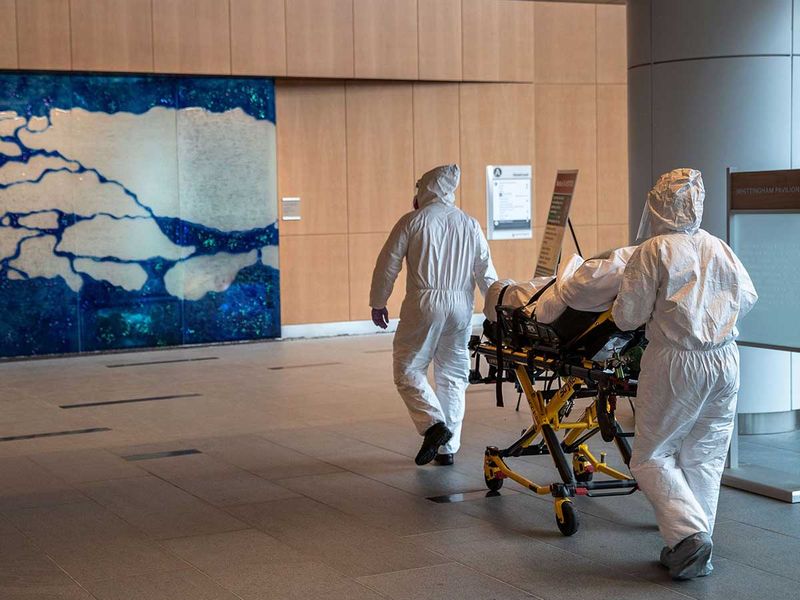
Highlights
- Largest known study of its kind based on the 1,959,982 COVID-19 patients evaluated for post-COVID conditions.
- Study identified 5 most common post-COVID conditions — pain, breathing difficulties, hyperlipidemia, malaise and fatigue, and hypertension.
- 23.2% of patients who had COVID-19, had at least one of these post-COVID conditions.
- Longitudinal studies provide evidence to aid the identification of people at high risk for post-COVID-19 syndrome.
Do “asymptomatic” people also suffer from post-COVID conditions? A new study gives a data-driven answer: Yes.
In the largest known study based on the population of COVID patients, researchers stated that post-COVID conditions can last for months — even nine months — and may be experienced by 10% to 30% of COVID-19 patients.
The conditions — dyspnea, fatigue/muscular weakness and post-traumatic stress disorder (PTSD), reduction in health-related quality of life scores, pulmonary function abnormalities and radiographic abnormalities — are also found in a “substantial” percentage of patients whose cases initially lacked symptoms — asymptomatic.
Researchers point out that such studies provide early evidence to aid the identification of people at high risk for post-acute COVID-19. The severity of illness during acute COVID-19 (ICU admission and/or requirement for non-invasive and/or invasive mechanical ventilation) has been significantly associated with the presence or persistence of symptoms. We break down it down for you:
What's the study all about?
The FAIR Health white paper focussed on the prevalence of acute post-COVID conditions of patients 30 days or more after their initial diagnosis with COVID-19.
It used big data analytics — “longitudinal” records — from a database of over 34 billion private healthcare claim records. Specifically, it analysed patients who exhibited "persistent or new symptoms" — more than four weeks after first being diagnosed. Patients with such post-COVID conditions are also referred to as having “long-haul COVID”, “long COVID” or “post-acute sequelae of COVID-19” (PASC).
1.96 m
Number of patient data analysed in FAIR Health study on post-COVID conditionsWho conducted the study?
FAIR Health, the largest repository of private claims data in the US, conducted and released the study. The group regularly publishes white papers based on massive patient data.
What was the study based on?
Using longitudinal data from a database of over 34 billion private healthcare claim records, FAIR Health studied a total of 1,959,982 COVID-19 patients for the prevalence of post-COVID conditions 30 days or more after their initial diagnosis with COVID-19.
The study tracked the health insurance records of people who contracted the coronavirus in 2020. It found that 30 days or more after their infection, nearly one out of four — 23% — of them sought medical treatment for new conditions.
What are the study highlights?
The white paper states the following:
- It’s the largest population of COVID-19 patients tracked for post-COVID conditions.
- The patients’ post-COVID conditions were analysed, with the most common conditions identified.
- “Post-COVID conditions” were found mostly in patients who had more severe cases of COVID-19.
- The conditions are also found in a “substantial” percentage of patients whose cases lacked symptoms — or “asymptomatic” people.
- 50% of those who had a post-COVID condition were hospitalised with COVID-19.
- 27.5% of those who had the condition were symptomatic but not hospitalised.
- 19% of those who had the condition were “asymptomatic”.
What are the 5 most common post-COVID conditions across all ages?
![Seyyed dela Llata / Gulf News / FAIR Health study [https://bit.ly/2Szqq14]](https://imagevars.gulfnews.com/2021/06/17/Seyyed-dela-Llata---Gulf-News---FAIR-Health-study--https---bit.ly-2Szqq14-_17a19ed5948_original-ratio.jpg)
Did COVID-19 affect patients in the study the same way?
No. The ranking of the most common post-COVID conditions varied by age group. For example:
- in the paediatric population (0-18), pain and breathing difficulties were the top two conditions.
- Pain and breathing difficulties were also reported in the all-ages cohort.
- Intestinal issues, rather than hyperlipidemia, were the third most common among paediatric population.
- In terms of gender: Most of the post-COVID conditions that were evaluated were associated more with females than males.
- In the case of 12 conditions, however, males more commonly had the condition diagnosed than females.
- For example, of patients who had post-COVID cardiac inflammation, 52% were male and 48% female.
- By age, the largest share (25.%) with this condition was found in a young cohort — individuals aged 19-29.
173.17 m
number of people who recovered from COVID-19, out of 177 million cases recorded worldwide as of June 17Did the study analyse the mental health of recovered COVID-patients?
Four mental health conditions were evaluated as post-COVID conditions. The mental health conditions associated with the highest percentage of patients after COVID-19 in all age groups are:
- Anxiety
- Depression
- Adjustment disorders
- Tic disorders

What are the risks of death among hospitalised COVID patients?
Thirty (30) days or more after initial diagnosis with COVID-19, the odds of death were 46 times higher for patients who were hospitalised with COVID-19 and discharged than patients who had not been hospitalised, the the study said. Of COVID-19 patients who were hospitalised and discharged, 0.5% died 30 days or more after their initial diagnosis.
What is the risk of death among COVID having pre-existing conditions?
The odds of death were highest — more than 3 times — among those with intellectual disabilities were associated COVID 30 days or more after initial diagnosis.
What are some of post-COVID-19 complications?
Among the most common “complications” observed by doctors based on the FAIR Health data:
- Fibrosis of lungs
- Cardiac arrest
- Renal failure
- Neurological problems
- Diabetes
- Mucormycosis
Were these similar studies conducted earlier?
The FAIR Health study results reflect multinational clinical studies conducted in Italy, UK, France, US, Spain and China focussing on the condition known as “post-acute COVID-19 syndrome”. Nine teams conducted studies on 3,398 patients over six months post the onset of symptoms, results of which were published in the journal Nature in March 2021.

Observational studies:
Observational cohort studies in the US (38 hospitals), Europe (Italy, Spain and the UK) and China (Wuhan) evaluated the outcomes of nearly 4,000 recovered patients.
US study
The US study utilised medical records and telephone surveys (referred to as the “post-acute COVID-19 US study). Of 488 patients included in this study, 6.7% of patients died during the study period; 15.1% of patients required re-admission (within 60 post hospital discharge). Key findings:
- 32.6%: patients who reported “persistent symptoms” (including 18.9% with “new” or “worsened symptoms”)
- 22.9%: patients who reported dyspnea while walking up the stairs
- 15.4%: Cough
- 13.1%: Persistent loss of taste and/or smell
European study
In the European study (608 individuals who survived COVID-19 in Italy, the UK, France and Spain), reported similar findings: Fatigue, dyspnea and psychological distress, such as post-traumatic stress disorder (PTSD), anxiety, depression and concentration and sleep abnormalities — noted in approximately 30% or more study participants at the time of follow-up (8 too 12 weeks after 8 to 14 after disease one and up to 8 weeks post-hospital discharge.
China study
Another cohort study from Wuhan, China, tracked long-term consequences of acute COVID-19 via in-person evaluation of 1,733 patients 6 months from symptom onset. The Wuhan study (via survey questionnaires, physical examination, 6-minute walk tests and blood tests and pulmonary function tests, high-resolution computed tomography of the chest and ultrasonography to evaluate post-acute COVID-19 end organ injury.) A majority of the patients (76%) reported at least one symptom. Following are the conditions in the post-acute COVID cases:
- 63%: Fatigue/muscular weakness
- 26%: Sleep difficulties:
- 23%. Anxiety/depression:
Source: Nature [https://go.nature.com/3gJ1g80]





